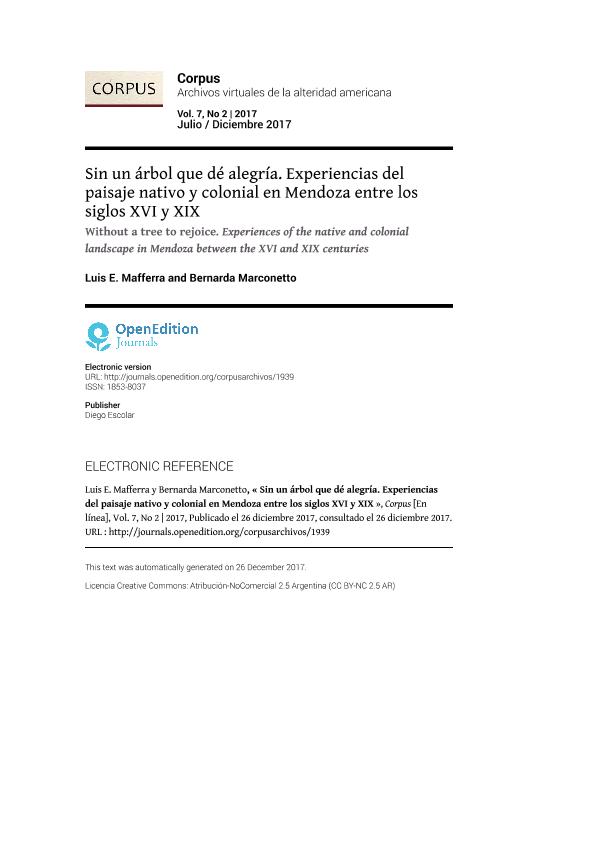Artículo
A partir de las concepciones actuales sobre el ambiente en la provincia de Mendoza (Argentina), analizamos en este trabajo información documental sobre sus raíces históricas. Más precisamente, observamos testimonios sobre la experiencia del ambiente entre los siglos XVI y XIX, detectando indicios que permiten comprenderla en el contexto de la esquematización de modalidades de relación entre la sociedad y su entorno. Nos interesa especialmente observar el lugar de las plantas en este proceso; ya que en base a datos arqueológicos e históricos se ha corroborado que el período de estudio incluyó cambios en la conformación de los paisajes forestales. Asimismo, definimos a grandes rasgos unidades de análisis diferenciadas por la asociación de materialidades-significados que conformaron paisajes específicos, más precisamente, el paisaje nativo y el colonial. Los datos analizados permiten observar disposiciones de relación diferentes entre ambas; resultando los árboles y arbustos posibles elementos claves en la modelación de las experiencias. Estas interpretaciones habilitan para retomar el debate que sirvió de punto de partida discutiendo, a razón de la información histórica presentada y las interpretaciones construidas a lo largo del trabajo, las implicancias de las actuales conceptualizaciones y modos de relación con el ambiente en la región. Starting off from the current environmental conceptions in the Mendoza province (Argentina), we analyze here documentary information about its historical roots. More precisely, we observe testimonies about the experience of the environment between the sixteenth and nineteenth centuries, detecting clues allowing context understanding of the schematization of modalities in the relationship between society and its environment. We are particularly interested in observing the place of the plants in this process; since from archaeological and historical data it has been corroborated that the period of study covered changes in the conformation of the forest landscapes. For this purpose, we broadly define units of analysis differentiated by the association of materialities-meanings that conformed specific landscapes, more precisely, the native and colonial landscape. The analyzed data allows for observation of different relationship between both; resulting trees and shrubs possible key elements in the modeling of experiences. These interpretations make it possible to resume the debate that was used as a starting point, discussing, on the basis of the historical information presented and the interpretations built throughout the paper, the implications of current conceptualizations and modes of relation with the environment in the region.
Sin un árbol que dé alegría. Experiencias del paisaje nativo y colonial en Mendoza entre los siglos XVI y XIX
Título:
Without a tree to rejoice. Experiences of the native and colonial landscape in
Mendoza between the XVI and XIX centuries
Fecha de publicación:
12/2017
Editorial:
Diego Escolar
Revista:
Corpus
ISSN:
1853-8037
Idioma:
Español
Tipo de recurso:
Artículo publicado
Clasificación temática:
Resumen
Palabras clave:
Paisajes
,
Colonizacion
,
Arboles
,
Experiencias
Archivos asociados
Licencia
Identificadores
Colecciones
Articulos(IANIGLA)
Articulos de INST. ARG. DE NIVOLOGIA, GLACIOLOGIA Y CS. AMBIENT
Articulos de INST. ARG. DE NIVOLOGIA, GLACIOLOGIA Y CS. AMBIENT
Citación
Mafferra, Luis Eduardo; Marconetto, María Bernarda; Sin un árbol que dé alegría. Experiencias del paisaje nativo y colonial en Mendoza entre los siglos XVI y XIX; Diego Escolar; Corpus; 7; 2; 12-2017; 1-22
Compartir
Altmétricas




